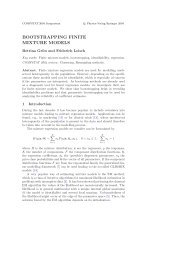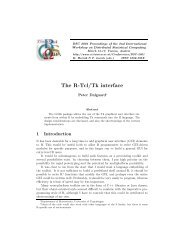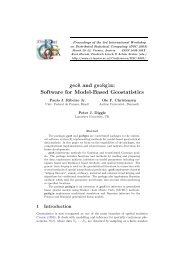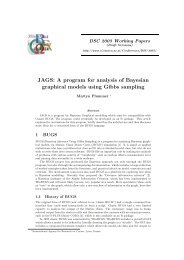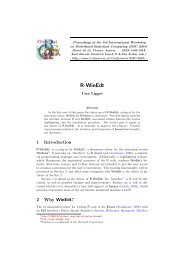Embedding R in Windows applications, and executing R remotely
Embedding R in Windows applications, and executing R remotely
Embedding R in Windows applications, and executing R remotely
Create successful ePaper yourself
Turn your PDF publications into a flip-book with our unique Google optimized e-Paper software.
The Extreme Value Toolkit (extRemes):<br />
Weather <strong>and</strong> Climate Applications of Extreme Value Statistics<br />
Eric Gillel<strong>and</strong>, Rick Katz <strong>and</strong> Greg Young<br />
The Extremes toolkit, extRemes, is part of the recent Weather <strong>and</strong> Climate<br />
Impact Assessment Science Initiative undertaken at the National Center<br />
for Atmospheric Research (NCAR). The toolkit reflects an effort to develop<br />
software for the fitt<strong>in</strong>g of meteorological extremes <strong>in</strong> a form accessible to the<br />
broader atmospheric science community. The software used by the toolkit for<br />
fitt<strong>in</strong>g meteorological extremes was provided by Stuart Coles <strong>and</strong> ported <strong>in</strong>to<br />
R by Alec Stephenson as the R package ismev. The primary excit<strong>in</strong>g new<br />
<strong>applications</strong> <strong>in</strong> R are graphical user <strong>in</strong>terface (GUI) dialogs via tcltk for the<br />
ismev functions (plus a few new functions) with an accompany<strong>in</strong>g tutorial on<br />
how to use the toolkit, with examples of model<strong>in</strong>g meteorological extremes.<br />
The package has been implemented <strong>and</strong> tested on unix, l<strong>in</strong>ux <strong>and</strong> W<strong>in</strong>dows<br />
operat<strong>in</strong>g systems. Although the emphasis of the toolkit, <strong>and</strong> particularly the<br />
accompany<strong>in</strong>g tutorial, is on extreme weather <strong>and</strong> climate events, the toolkit<br />
itself can be used with any sort of data where extreme value methods are<br />
appropriate.<br />
An important part of the <strong>in</strong>itiative focuses on extreme weather <strong>and</strong> climate<br />
events, <strong>and</strong> the toolkit is <strong>in</strong>tegral to meet<strong>in</strong>g the goals for this component<br />
of the <strong>in</strong>itiative. Specifically, it is hoped that the toolkit will prompt more<br />
use of (i) extreme value methodology when analzy<strong>in</strong>g weather <strong>and</strong> climate<br />
extremes, (ii) <strong>in</strong>formation about upper tail of distribution (via po<strong>in</strong>t process<br />
approach <strong>in</strong>stead of block maxima), (iii) climate change detection by way of<br />
extreme value methodology with trends <strong>in</strong>troduced through covariates <strong>and</strong> (iv)<br />
development of more physically realistic statistical models for extremes (via<br />
covariates for annual <strong>and</strong> diurnal cycles as well as for physical variables such<br />
as El Niño events).<br />
To accomplish these goals, the toolkit uses GUI dialogs to make it as easy<br />
as possible for scientists not familiar with R to get started <strong>and</strong> have access<br />
to extreme value software with a small learn<strong>in</strong>g curve; provides an <strong>in</strong>-depth<br />
accompany<strong>in</strong>g tutorial to <strong>in</strong>troduce scientists who may be unfamiliar with<br />
extreme value methods to some of the basic pr<strong>in</strong>ciples; <strong>and</strong> through both the<br />
tutorial <strong>and</strong> the design of the software facilitates easy adaptation of the code<br />
for specific problems.<br />
So far the toolkit only h<strong>and</strong>les univariate data, except that covariates may<br />
be <strong>in</strong>corporated <strong>in</strong>to model parameters. One possible future addition to the<br />
toolkit would be to add software that can directly support multivariate models;<br />
because weather <strong>and</strong> climate studies generally occur spatially <strong>and</strong> it is desired<br />
to <strong>in</strong>corporate spatial dependence <strong>in</strong>to the models.<br />
1




